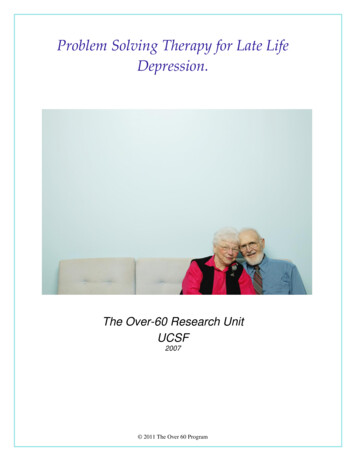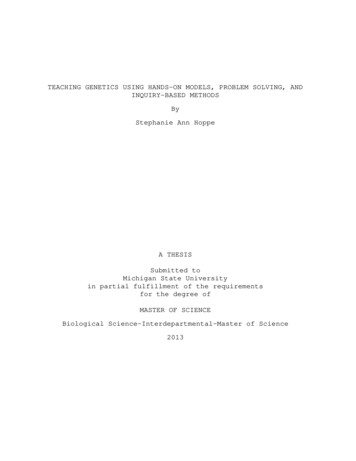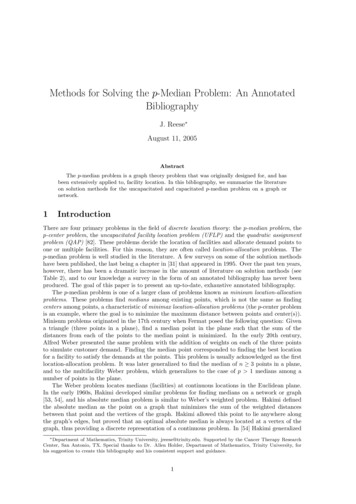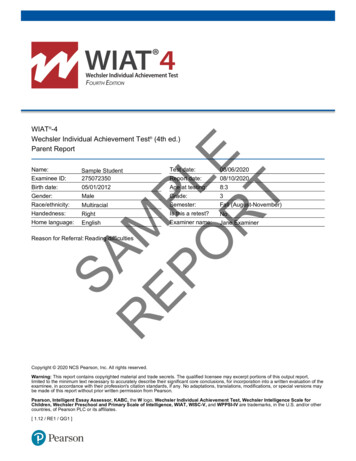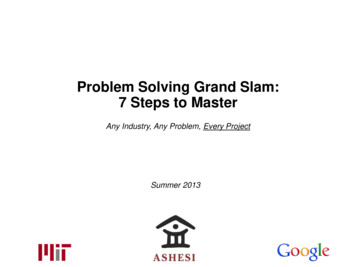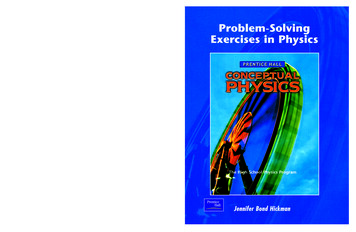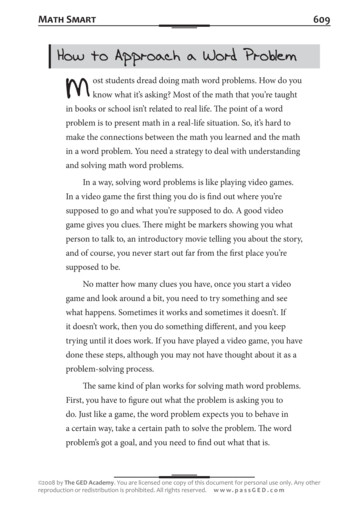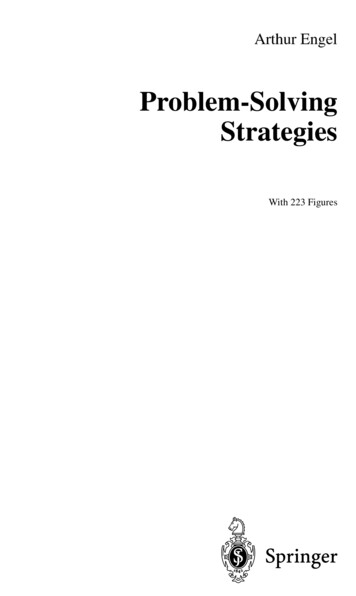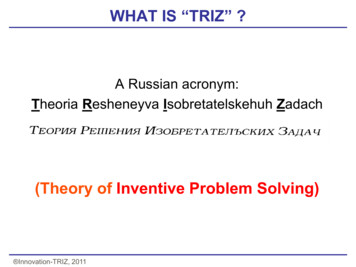
Transcription
WHAT IS “TRIZ” ?A Russian acronym:Theoria Resheneyva Isobretatelskehuh Zadach(Theory of Inventive Problem Solving)Problems)What are these? Innovation-TRIZ, 2011
TRIZ One can think of TRIZ as another way ofLateral Thinking. TRIZ is based on two basic principles--Somebody, sometime, somewhere hasalready solved your problem or one similar to it.Creativity means finding that solution andadapting it to the current problem.--Don’t accept contradictions. Resolve them.Department of Chemical Engineering, University of Michigan, Ann Arbor5/1/20132
Use the Defect as a Resourceto Solve the ProblemDepartment of Chemical Engineering, University of Michigan, Ann Arbor5/1/20133
SYSTEM PROPOSAL AND CHALLENGE Replace inspectors with a 200K videoinspection system High return project, but capital is not available Boss says, that’s a great idea, but “Find anotherway!!” Innovation-TRIZ, 2011
GOOD PILLS/BAD PILLS What is IDEALITY/IDEA FINAL RESULT?We do not want any bad pills in the bottles. What are the RESOURCES we have?Can we use the defect as a resource to solvethe problem? Innovation-TRIZ, 2011
Empty Bath Soap BoxesDepartment of Chemical Engineering, University of Michigan, Ann Arbor5/1/20136
Soap DefectSoapX-Ray
Empty Bath Soap Boxes What is IDEALITY/IDEA FINAL RESULT?We do not want to ship any empty soap boxes What are the RESOURCES we have?Can we use the defect as a resource tosolve the problem? Innovation-TRIZ, 2011
Soap DefectSoapWind
TRIZ Everyday Examples Automobile air bags deploy quickly to protect thepassenger (good),butthe more rapidly they deploy, the more likely theyare to injure or kill small or out-of-position people(bad).Department of Chemical Engineering, University of Michigan, Ann Arbor5/1/201310
TRIZ Everyday Examples con’t Cell phone networks should have excellentcoverage so users have strong signals (good),butcell phone towers are not very nice to look at (bad).Department of Chemical Engineering, University of Michigan, Ann Arbor5/1/201311
TRIZ Everyday Examples con’t The email spam filter should be efficient enough toremove all my junk emails (good),butthen it is more likely to screen some emails that Iactually want to receive (bad).Department of Chemical Engineering, University of Michigan, Ann Arbor5/1/201312
39 TRIZ Features1: Weight of moving object14: Strength27: Reliability2: Weight of stationary object15: Durability of moving object28: Measurement accuracy3: Length of moving object16: Durability of non moving object29: Manufacturing precision4: Length of stationary object17: Temperature30: Object-affected harmful5: Area of moving object18: Illumination intensity31: Object-generated harmful6: Area of stationary object19: Use of energy by moving object32: Ease of manufacture7: Volume of moving object20: Use of energy by stationaryobject33: Ease of operation8: Volume of stationary object21: Power34: Ease of repair9: Speed of object22: Loss of Energy35: Adaptability or versatility10: Force (Intensity)23: Loss of substance36: Device complexity11: Stress or pressure24: Loss of Information37: Difficulty of detecting12: Shape25: Loss of Time38: Extent of automation13: Stability of the object26: Quantity of substance39: ProductivityDepartment of Chemical Engineering, University of Michigan, Ann Arbor5/1/201313
TRIZ FeaturesTitleExplanationMoving objectsObjects which can easily change position in space,either on their own, or as a result of external forces.Vehicles and objects designed to be portable are thebasic members of this class.Objects which do not change position in space, either ontheir own, or as a result of external forces. Consider theconditions under which the object is being used.Stationary objectsDepartment of Chemical Engineering, University of Michigan, Ann Arbor5/1/201314
TRIZ FeaturesTitleExplanation1. Weight of moving objectThe mass of the object, in a gravitational field. The forcethat the body exerts on its support or suspension.The mass of the object, in a gravitational field. The forcethat the body exerts on its support or suspension, or onthe surface on which it rests.Any one linear dimension, not necessarily the longest, isconsidered a length.Same.2. Weight of stationary object3. Length of moving object4. Length of stationary object5. Area of moving object6. Area of stationary object7. Volume of moving object8. Volume of stationary objectA geometrical characteristic described by the part of aplane enclosed by a line. The part of a surface occupiedby the object. OR the square measure of the surface,either internal or external, of an object.SameThe cubic measure of space occupied by the object.Length x width x height for a rectangular object, height xarea for a cylinder, etc.SameDepartment of Chemical Engineering, University of Michigan, Ann Arbor5/1/201315
TRIZ Web Sitehttp://www.triz40.com/Department of Chemical Engineering, University of Michigan, Ann Arbor5/1/201316
Improve39x39 Contradiction MatrixDepartment of Chemical Engineering, University of Michigan, Ann Arbor5/1/201317
TRIZ Contradiction MatrixWorsening Feature1: Weight of moving object2: Weight of stationary object3: Length of moving object4: Length of stationaryobject5: Area of moving object15, 81: Weight of movingobject*-29, 34-2: Weight of stationaryobject-*-29, 353: Length of movingobject4: Length of stationaryobject5: Area of movingobjectImproving Feature6: Area of stationaryobject7: Volume of movingobject-40, 292, 1729, 4*10: Force (Intensity)11: Stress or pressure12: Shape13: Stability of theobject14: Strength4-14, 182, 2629, 40---*-10, 40-*--*14, 1518, 426, 7-9, 391, 7-19, 142, 289: Speed of object-17, 730, 2-13, 215, 1735, 28-35, 30-8, 154, 3535, 108: Volume of stationaryobject38, 3410, 129, 346: Area of stationary object29, 171, 7-4, 17---35, 819, 142, 1413, 1413, 38-88118 1317 1929, 30-34-19 101 1837 181 289 3628 101536 3710 3613 2935 1035 110 1510 1537 4010 183614 1636 2836 378 1015 1029 3413 145 3429 4026 35410 74 1021 3526 3913 152 391 401 28371840 261 1540 1527 18 35Department of Chemical Engineering, University of Michigan, Ann Arbor-2 11133915 143 349 4028 2640 29285/1/201318
Altshuller’s 40 Principles of 9.20.SegmentationTaking outLocal QualityAsymmetryMergingUniversality“Nested doll”Anti-weightPreliminary anti-actionPreliminary actionBeforehand cushioningEquipotentialityThe other way aroundSpheroidalityDynamicsPartial or excessive actionsAnother dimensionMechanical vibrationPeriodic actionContinuity of useful actionDepartment of Chemical Engineering, University of Michigan, Ann Arbor21. Skipping22. “Blessing in disguise”23. Feedback24. ‘Intermediary’25. Self-service26. Copying27. Cheap short-living28. Mechanics substitution29. Pneumatics and hydraulics30. Flexible shells and thin films31. Porous materials32. Color changes33. Homogeneity34. Discarding and recovering35. Parameter changes36. Phase transitions37. Thermal expansion38. Strong oxidants39. Inert atmosphere40. Composite material films5/1/201319
TRIZ Web Sitehttp://www.triz40.com/Department of Chemical Engineering, University of Michigan, Ann Arbor5/1/201320
40 Inventive Principles With ExamplesPrinciple 2. Taking outA. Separate an interfering part or property from an object,or single out the only necessary part (or property) of anobject.
40 Inventive Principles With ExamplesPrinciple 2. Taking outA. Separate an interfering part or property from an object,or single out the only necessary part (or property) of anobject.Locate a noisy compressor outside the building wherecompressed air is used.Use fiber optics or a light pipe to separate the hot lightsource from the location where light is needed.Use the sound of a barking dog, without the dog, as aburglar alarm.
40 Inventive (Business) Principles With ExamplesPrinciple 7. “Nested Doll”A. Place one object inside another; place each object, inturn, inside the other. Store-in-store (Kinkos FedEx)
40 Inventive (Business) Principles With ExamplesPrinciple 7. “Nested Doll”B. Make one part pass through a cavity in the other. Plug holes in organisation structure Door sensors count customers into and out of a store/office,etc (use data for market profiling, etc) Casino hotel architecture (Las Vegas style): The guest mustpass through the gaming area to get to the restaurant, thehotel registration, even the lavatories!
Example Application of TRIZA New Structural Material for Bullet Proof Garment Statement: Bullet proof vests shouldbe strong, but not heavy.Department of Chemical Engineering, University of Michigan, Ann Arbor5/1/201325
Example Application of TRIZA New Structural Material for Bullet Proof GarmentStatement: Bullet proof vests should bestrong, but not heavy.Step 1 –Identify the contradiction(s)Strength (improves) versusWeight (worsens)Department of Chemical Engineering, University of Michigan, Ann Arbor5/1/201326
Example Application of TRIZA New Structural Material for Bullet Proof GarmentStatement: Bullet proof vests should be strong,but not heavy.Step 1 –Step 2 –Identify the contradiction(s)Strength (improves) versusWeight (worsens)Look at the list of features and identifythose important to your contradiction.Strength – #14Weight – #2Department of Chemical Engineering, University of Michigan, Ann Arbor5/1/201327
Example Application of TRIZA New Structural Material for Bullet Proof GarmentStatement: Bullet proof vests should be strong, but not heavy.Step 1 –Identify the contradiction(s)Strength (improves) versusWeight (worsens)Step 2 – Look at the list of features and identifyto your contradiction.Strength – #14Weight – #2those importantStep 3 Identify Which Are Improving Features andWhich Are Worsening FeaturesStrength (feature 14) improvesWeight (feature 2) worsensDepartment of Chemical Engineering, University of Michigan, Ann Arbor5/1/201328
2: Weight ofstationary object1: Weight ofmoving object2: Weight ofstationaryobject3: Length ofmoving object4: Length ofstationaryobject5: Area ofmoving object6: Area ofstationaryobject*-8, 1529, 342, 1729, 4-2, 267: Volume ofmoving object29, 408: Volume ofstationaryobject-9: Speed ofobject10: Force(Intensity)11: Stress orpressure2, 2813, 388137 1810 3637 408 1012: Shape13: Stability ofthe object29 4021 352 3940,2614: StrengthDepartment of Chemical Engineering, University of Michigan, Ann Arbor27,15/1/201329
Example Application of TRIZA New Structural Material for Bullet Proof GarmentStep 4 –Refer to the TRIZ Contradiction Matrix to learn which of Altshuller’sPrinciples may be useful for this problem.The intersection of Column 2 and Row 14 gives the following principles1262740Department of Chemical Engineering, University of Michigan, Ann Arbor5/1/201330
Altshuller’s 40 Principles of 9.20.SegmentationTaking outLocal QualityAsymmetryMergingUniversality“Nested doll”Anti-weightPreliminary anti-actionPreliminary actionBeforehand cushioningEquipotentialityThe other way aroundSpheroidalityDynamicsPartial or excessive actionsAnother dimensionMechanical vibrationPeriodic actionContinuity of useful actionDepartment of Chemical Engineering, University of Michigan, Ann Arbor21. Skipping22. “Blessing in disguise”23. Feedback24. ‘Intermediary’25. Self-service26. Copying27. Cheap short-living28. Mechanics substitution29. Pneumatics and hydraulics30. Flexible shells and thin films31. Porous materials32. Color changes33. Homogeneity34. Discarding and recovering35. Parameter changes36. Phase transitions37. Thermal expansion38. Strong oxidants39. Inert atmosphere40. Composite material films5/1/201331
Example Application of TRIZA New Structural Material for Bullet Proof GarmentStep 4 –Refer to the TRIZ Contradiction Matrix to learn which of Altshuller’sPrinciples may be useful for this problem.Row 14 (Strength) and Column 2 (Weight) of the Contradiction Matrixindicate the following Principles may be useful: 40, 26, 27, and 1. Wenow look at the Principles list to learn that these numbers correspondto1. Segmentation.26. Copying27. Cheap short living40. Composite materialsNext we brainstorm how we could use these four Principles to solveour problem.Department of Chemical Engineering, University of Michigan, Ann Arbor5/1/201332
40 Inventive Principles With ExamplesPrinciple 1. SegmentationA. Divide an object into independent parts.
40 Inventive Principles With ExamplesPrinciple 1. SegmentationA. Divide an object into independent parts.Replace mainframe computer by personal computers.Replace a large truck by a truck and trailer.Use a work breakdown structure for a large project.B. Make an object easy to disassemble.
40 Inventive (Business) Principles With ExamplesPrinciple 1. SegmentationB. Make an object easy to disassemble. Use of temporary workers on short-term projects Flexible Manufacturing Systems Modular furniture/offices Container shipmentC. Increase the degree of fragmentation or segmentation. ‘Empowerment’ - segmentation of decision making. Distance learning (also ‘Taking Out’) Virtual office/remote working (also ‘Taking Out’)
Example Application of TRIZA New Structural Material for Bullet Proof Garment1. SegmentationPerhaps we could consider several different coveringsfor different parts of the body (pants, vest, etc.) ratherthan a one-piece suit.Maybe different materials to cover the critical areassuch as chest and head, each taking advantage ofspecific properties that would be customized for theirdiffering applications.Department of Chemical Engineering, University of Michigan, Ann Arbor5/1/201336
Example Application of TRIZA New Structural Material for Bullet Proof Garment26. CopyingThe explanation of this Principle from the TRIZ website is:– Instead of an unavailable, expensive, fragile object, usesimpler and inexpensive copies.– Replace an object, or process with optical copies.We could copy the design of abbreviated scuba diving wetsuits for use as a bullet proof garment.Department of Chemical Engineering, University of Michigan, Ann Arbor5/1/201337
Example Application of TRIZA New Structural Material for Bullet Proof Garment27. Cheap short-living objectsThe explanation of this Principle from the TRIZ website is:– Replace an inexpensive object with a multiple ofinexpensive objects, comprising certain qualities (suchas service life, for instance).This Principle does not appear to be readily applicable tothis problem. This occurance is not necessarily unusual,because these Principles are only general suggestions tohelp focus our thinking in areas that have proven fruitful inprevious problems.Department of Chemical Engineering, University of Michigan, Ann Arbor5/1/201338
Example Application of TRIZA New Structural Material for Bullet Proof Garment40. Composite materialsThe explanation of this Principle from the TRIZ website is:Change from uniform to composite (multiple) materials.- Composite epoxy resin/carbon fiber golf club shafts arelighter, stronger, and more flexible than metal. Same forairplane parts.- Fiberglass surfboards are lighter and more controllableand easier to form into a variety of shapes than woodenFor lighter-weight, stronger vests, the use of compositesis an active area of research.Polymers (Kevlar) reinforced with carbon nanofibers arecurrently being investigated as a strong lightweightalternative to steel for structural materials.Department of Chemical Engineering, University of Michigan, Ann Arbor5/1/201339
TRIZKevlar vests are now common place amongpolice officers and soldiersEpilogBy identifying problem contradictions, the elements ofTRIZ can be used to help reach a solution. Using theTRIZ method, we were able to generate two additionalideas.TRIZ Motto: If the tools of TRIZ are used in aneffective manner the major challenges of today willbe resolved more rapidly to produce the successstories of tomorrow.Department of Chemical Engineering, University of Michigan, Ann Arbor5/1/201340
The Boeing 737A TRIZ problem solving team was called to theBoeing factor in Seattle, Washington to see howthe capacity of the Boeing 737-100 could beincreased.Department of Chemical Engineering, University of Michigan, Ann Arbor5/1/201341
The airplane engine is the moving object. We would needthe engine air intake and the fuel injection casing to belarger so the improving feature is engine volume. the but ifwe increase the volume of the engine it will decrease theclearance distance between the bottom of the engine andthe ground (worsening feature). The improving feature isnumber 7.“Volume of moving object (engine) and theworsening feature is “3. Length (diameter) of the movingobject (clearance).Department of Chemical Engineering, University of Michigan, Ann Arbor5/1/201342
Solution to Boeing 737Department of Chemical Engineering, University of Michigan, Ann Arbor5/1/201343
The engine intake area and the cowl with the fuel linesmake up the engine volume, thus an improving feature willbe the “7. Volume of the moving object” and the worseningfeature again “3. Length (engine diameter, i.e., clearance).”This intersection gives4. Asymmetry1. Segmentation7. Nested Dolls35. Parameter ChangesDepartment of Chemical Engineering, University of Michigan, Ann Arbor5/1/201345
We note the 737-200 engines are circular in boththe intake area and the area plus the casing.Nowlet’slookatAtlshulerPrinciple1. Segmentation.We have the engine air intake area and the area ofthe casing surrounding the intake. The intake areamust be circular because of the spinning bladesinside the engine.Department of Chemical Engineering, University of Michigan, Ann Arbor5/1/201346
Now let’s look at the principle number4. Asymmetry.Does the intake area plus the casing needto be symmetric? No it does not.Department of Chemical Engineering, University of Michigan, Ann Arbor5/1/201347
Let’s look at number 7. Nesting.Could the symmetrical blades and moving parts be“nested” inside an asymmetrical casing?What if we were to make the air intake areasymmetrical but make the casing plus intake areaasymmetrical so as to flatten the bottom and thusleave a great clearance?If you look at the engines of the new 737s you willnotice this solution was implemented.Department of Chemical Engineering, University of Michigan, Ann Arbor5/1/201348
Department of Chemical Engineering, University of Michigan, Ann Arbor5/1/201349
Solution : Cylindrical Intake but Oval Engine Casing
Mechanics substitution 29.Pneumatics and hydraulics 30.Flexible shells and thin films 31.Porous materials Color changes Homogeneity 34.Discarding and recovering 35.Parameter changes 36.Phase transitions 37.Thermal expansion 38.Strong
